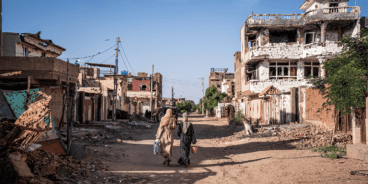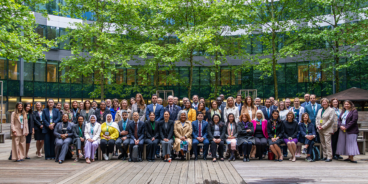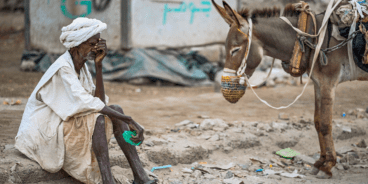
Highlights from the Opening of the 66th United Nations General Assembly
Strong support for the Responsibility to Protect (R2P) populations from genocide, war crimes, crimes against humanity and ethnic cleansing was clearly evident at the opening of the 66th United Nations (UN) General Assembly between 21 and 27 September 2011. From the Secretary-General’s reference to R2P as a priority for his second term, to the re-affirmation of government support for the norm in opening statements and the holding of a Ministerial meeting on R2P, clear consensus exists about the critical importance of R2P. At a moment when some were anticipating a backlash in the aftermath of the Security Council authorized civilian protection operation in Libya, the opening of the General Assembly reaffirmed that the imperative today is for states to work together to operationalize R2P.
This document will discuss the six significant ways in which enduring commitment to R2P was visible during the two weeks of the opening of the 66th UN General Assembly.
United Nations Secretary-General Ban Ki-moon Reiterated His Commitment to R2P
In his opening address to the General Assembly the Secretary-General cited advancing conflict prevention and R2P as key issues that he will pursue during his second term. He noted that, “We have carved out new dimensions for the Responsibility to Protect. We will continue.” His resolve to operationalize R2P was also evident in his statement at the Ministerial meeting on R2P where he said:
“By now it should be clear to all that the Responsibility to Protect has arrived. This can be seen not only in our collective actions in Côte d’Ivoire and Libya, but also in our diplomacy. Our challenge now is to keep all Charter-based options open, and all of our collective tools sharp. We need to strengthen ties with our regional, sub-regional and civil society partners. We need to share information and assessments about States under stress. Effective prevention requires early, active and sustained engagement. We also need to look at our development, capacity-building and peacebuilding programmes through the lens of atrocity prevention to be sure they are healing fissures within societies, not deepening them. Prevention does not always work. So our strategy must also include ways to generate the kind of ‘timely and decisive’ response the Summit called for and our people expect.”
A Diverse Group of Foreign Ministers Met to Discuss R2P Post-Libya
On 23 September, the governments of the Netherlands and Guatemala along with the Global Centre for the Responsibility to Protect hosted the 4th annual Ministerial meeting on R2P. With 25 states participating, the meeting saw new actors join the discussion. For the first time Brazil, France, Egypt, and Qatar participated alongside their counter-parts from such states as Chile, Indonesia, Botswana, the United Kingdom and the United States.
Participants stressed their resolve to protect populations from mass atrocities, emphasized the need for early engagement and prevention, and the importance of learning lessons from the international community’s protective responses in Côte d’Ivoire and Libya. The Secretary-General’s comments towards the end of the meeting captured the sentiment in the room; “In the six short years since its endorsement by the World Summit, this doctrine has gone from crawling to walking to running. Our job is to keep it moving and on track as we move from words to deeds.… I would far prefer the growing pains of an idea whose time has come to sterile debates about principles that are never put into practice. The world has seen too much of the latter and too little of the former.”
Re-affirmation of Support for R2P in Government Statements
During the opening debate at the 66th session of the General Assembly 18 states, 1 regional organization and 1 observer referred directly to R2P in their statements – an increase from last year’s references with a number of additional states referring to the pillars and principles underpinning R2P. The states referring directly to R2P were: Brazil, Estonia, Paraguay, Zimbabwe, Costa Rica, Ghana, Sweden, Macedonia, Luxembourg, Belgium, Italy, Syria, Cuba, the Netherlands, Nicaragua, Liechtenstein, Norway and Benin. The regional organization and observer were the European Union and the Holy See. The statements were overwhelmingly supportive of R2P with those states that raised concerns mainly focusing upon operational challenges and the need for consistency, rather than on contesting the existence of the norm. The diversity in statements is evident in this small sample:
Estonia
“Once again ongoing events underline the need for us to focus on the protection of civilians from atrocities. Even in the democratic part of my continent, the political project we today call the European Union was a reaction to mass murder and war. The very history of Europe motivates us to take preventive steps to avoid any repetition of such crimes. Therefore it is vital that we develop common practices and the capacity to implement the principle of R2P, better known as responsibility to protect.”
Ghana
“We are also committed to the global norm of the Responsibility to Protect (R2P) and will continue to work closely with member-states, UN Friends of R2P, and the UN as a whole.”
Belgium
“Instead of noninterference, Belgium believes in non-indifference. Sovereignty is no longer a wall leaders can use to violate the rights of their citizens. Sovereignty cannot be used as an excuse to run away from the responsibility to protect their people.”
Zimbabwe
“Mr. President, bilateral hatreds and quarrels or ulterior motives must not be allowed to creep into considerations of matters pertaining to threats to international peace and security, or to the principle of the Responsibility to Protect.”
Brazil
“We vehemently repudiate the brutal repression of civilian populations. Yet we remain convinced that for the international community, the use of force must always be a last resort… Much is said about the responsibility to protect; yet we hear little about responsibility in protecting. These are concepts that we must develop together.”
States Expressed Support for the Operationalization of R2P in Libya
States from Latin America to Asia used their statements as an opportunity to their express support for the action taken by the UN Security Council and broader international community to avert a massacre in Benghazi. A small minority raised concerns that the African Union’s mediation process was not given sufficient time to effect change while an even smaller number denounced all forms of military intervention as “imperialism.” The majority invoked R2P as the paradigm through which they understood the responsibility to act and subsequent measures taken. A sample of those references includes:
European Union
“When, earlier this year, there was the risk of a bloodbath in Benghazi, European leaders, together with others, acted with swiftness and determination, diplomatically (here in New York) and militarily. We could not allow the Libyan regime to take the lives of its own people. The principle of “responsibility to protect” was put into action – with perseverance and success.”
Botswana
“We commend the Security Council for its swift and resolute action on Libya, under resolution SC 1973, which authorized NATO to protect civilians in that country.”
United Kingdom
“The UN has to show that we can be – not just united in condemnation, but united in action acting in a way that lives up to the UNs founding principles and meets the needs of people everywhere…. In so doing, they stopped Benghazi from joining Srebrenica and Rwanda in history’s painful roll call of massacres the world failed to prevent.”
United Arab Emirates
“The UAE renews through this international platform its full commitment to the sovereignty, independence, territorial integrity and national unity of Libya. The UAE also stresses its commitment to the Security Council resolutions 1970 and 1973 of 2011 in regard to the protection of civilians.”
Liechtenstein
“We commend the Security Council for taking swift action to protect civilians in Libya and Côte d’Ivoire. In both instances, the Council authorized the use of force only as a last resort, but also without undue delay. Some have criticized the actions taken and argued that they are aimed at regime change. Let us not forget, however, that the regimes in question had a choice. It was them who chose to attack civilians. It was them who forced the international community to act.”
South Africa
“it is a matter of record now that the AU efforts were never given a chance. Military actions were preferred over peaceful means.”
Cuba
“The United States and NATO, supposedly to avoid a massacre, launched a military attack against a sovereign State without there being any threat to international peace and security, and unleashed a “change of regime” operation.”
States Called for R2P to be Upheld in Syria
Over 30 states used their statements as an opportunity to call upon the Syrian government to cease its attacks on civilians and to call for a unified international response to the crisis in Syria. From region to region states called upon the Security Council to act. Only a few statements warned the international community not to intervene in the internal affairs of the Syrian government – a sentiment that was rebuked by Turkey and others who clearly noted that governments that massacre their populations forfeit their legitimacy. The Syrian government did not argue whether R2P existed, rather it acknowledged it has a Responsibility to Protect and declared that it was upholding that responsibility. A sample of references includes:
Syria
“Syria exercised its responsibility to protect its citizens. It acted to guarantee their safety and stability.”
Sweden
“When there are threats of genocide, war crimes, ethnic cleansing or crimes against humanity – when autocratic rulers like in Syria turn their guns on their own citizens – then the international community has a responsibility to protect civilians.”
Liechtenstein
“At the same time, we sympathize with those who perceive selectivity in the application of the responsibility to protect. As the stalemate in the Security Council on Syria shows, politics at times continue to trump principles. In response, however, we need more principled action, not more politics.”
Mongolia
“The international community should not shy away from condemning the regime of Syria’s Bashar al-Asad, who has inhumanly and brutally chosen bloodshed to crack down on freedom and justice craving peaceful protesters by using combat vehicles, snipers and military force. Let us unanimously demand that he ends his atrocities.”
Turkey
“Sovereignty does not allow any leader or any regime to repress its own people or kill innocent civilians. A regime pointing guns to its own people can have no sovereignty or legitimacy.”
Botswana
“The Council’s condemnation of human rights violations and the military assault on civilians by Syria came rather too late… It failed to convey a clear and unequivocal message of revulsion to the Syrian authorities, and to urge them to respect international humanitarian law and human rights… Crimes against humanity have been committed in Syria…”
Cuba
“It is the task of this General Assembly to exercise its powers to prevent a military aggression against Syria. The public opinion should receive objective information and speak up against war.”
The United Nations Security Council Issued a Presidential Statement Referring to R2P
During the opening of the General Assembly the President of the Security Council, Lebanon, held a thematic dialogue in the Security Council on “Preventive Diplomacy” under the agenda item, “Maintenance of International Peace and Security.” The 22 September discussion resulted in the issuing of a Presidential Statement (S/PRST/2011/18). In the statement the Council made the following reference to the first pillar of R2P:
“The Security Council recalls that the prevention of conflict remains a primary responsibility of States, and further recalls their primary responsibility to respect and ensure the human rights of all individuals within their territory and subject to their jurisdiction, as provided for by relevant international law, and also reaffirms the responsibility of each individual State to protect its populations from genocide, war crimes, ethnic cleansing, and crimes against humanity.”
Conclusion
Conclusion At the outset of the General Assembly a group of eminent diplomats, all board members or patrons of the Global Centre for the Responsibility to Protect, called upon states to use the opening of the 66th session as an opportunity to set goals for advancing R2P over the next year. They noted that, “this past year has shown that states working together through international, regional and sub-regional organizations can, by employing a range of peaceful and coercive measures, deter and halt the commission of mass atrocities.”
Emphasizing the need to further operationalize R2P they called upon states to establish individual and collective benchmarks for actualizing the aspirations of R2P at the domestic and international level. In that vein they urged states to prioritize the following over the next year:
-
-
- Appoint a senior government official as a national focal point for R2P.
- Encourage all relevant UN agencies and departments to incorporate a R2P perspective into their activities.
- Use the tools available to the General Assembly to uphold R2P and take preventive and protective action.
- Work together to develop additional goals and benchmarks for advancing R2P.
-
We are heartened to see that member states have started to heed their call and that with each day we move closer to making the rhetoric of ‘never again’ a reality.
Related Content


11th Meeting of the Global Network of R2P Focal Points Outcome Document
